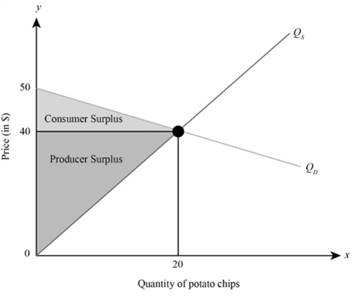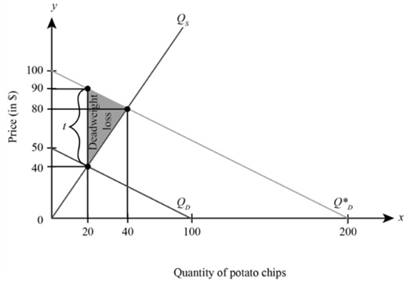
a)
To calculate: The
a)
Explanation of Solution
Given the following
The
To calculate equilibrium, we need to substitute
Hence, the equilibrium quantity and price with respect to given demand and supply function is Q = 20 and P = $40.
In order to calculate conumer surplus, producer surplus and social welfare we need to plot the above demand and supply function.

In the graph, the x axis depicts the quantity of potato chips and the y axis depicts the price per potato chips (in $),
Consumer surplus in the graph is represented by triangle A, so to compute consumer surplus, we need to calculate the area of the triangle. Thus, consumer surplus (CS) is
Producer surplus in the graph is represented by triangle B, so to compute producer surplus, we need to calculate the area of the triangle. Thus, producer surplus (PS) is
Social welfare (SW) is the sum of consumer surplus and producer surplus. Thus,
Introduction:
The equilibrium price is the defined as the price level at which both consumer and producer satisfies. It is the price where both want to exchange commodities and services.
b)
To compute: The equilibrium quantity, price, and
b)
Explanation of Solution
Given information:
Perceived demand function,
Supply function,
The equilibrium price is calculated by equating the supply and demand function. Thus, in equilibrium
In order to calculate equilibrium quantity, we need to substitute P = $80 into either the demand or supply function. Thus, equilibrium quantity is
Hence, the equilibrium quantity and price with respect to given demand and supply function is
In order to calculate deadweight loss we need to plot the above demand function and supply function. This has been done below:

In the graph, the x axis measures the quantity of potato chips and the y axis measures the price per potato chips (in $),
When it assumed that consumer behavious is influenced by his or her limited cognitive ability, then his percieved demand curve is
The deadweight loss indicating loss in social welfare due to extra purchase of potato chips than required is represented by triangle C and D. to compute the deadweight loss we need to calculate the area of triangle C and D. Thus
Thus, deadweight loss is
Introduction: A deadweight loss is an expense to economy that is caused by market failure, when supply and demand are out of equilibrium. Primarily used in economics, deadweight loss can be extended to any deficit caused by inadequate resource allocation.
c)
To compute: The per unit tax that the government could impose to correct the deadweight loss problem.
c)
Explanation of Solution
In order to correct the deadweight loss of 500 due to extra purchase of potato chips, government could impose a specific tax,
As a result, the consumer will reduce its purchase of potato chips from 40 units to 20 units on account of increased price of potato chips to $90.
Introduction: A deadweight loss is an expense to economy that is caused by market failure, when supply and demand are out of equilibrium. Primarily used in economics, the loss of deadweight can be extended to any deficit caused by inadequate resource allocation.
d)
To compute: The deadweight loss the governement has introduced with the tax if instead the government made a mistake and the second demand is actually the true demand stemming from rational decisions.
d)
Explanation of Solution
Dead weight loss happens when there is no equilibrium between supply and demand which leads to market failure. Market inefficiency happens when products are either overvalued or undervalued inside the industry. Although the disparity will favor some people in society, a change from equilibrium would negatively affect others.
If it is assumed that
Introduction: A deadweight loss is an expense to economy that is caused by market failure, when supply and demand are out of equilibrium. Primarily used in economics, the loss of deadweight can be extended to any deficit caused by inadequate resource allocation.
Want to see more full solutions like this?
Chapter 17 Solutions
EBK INTERMEDIATE MICROECONOMICS AND ITS
- True or false. The law of diminishing marginal utility predicts the consumption behavior of addicts quite wellarrow_forwardDamian and Kira trade in antique cars. They typically buy either 1 or 2 cars at any given time, since they are difficult to find and expensive. The price per car P(Q) where Qis the total number of cars traded at a given time, is determined by the demand equation: K P(Q) 1 where K is a positive constant. If a € {1, 2} is Damian's choice and b = {1,2} is Kira's choice, (so Q = (a + b)) it costs Damian 2a to find and prepare a cars for market, and it costs Kira 3b to get b cars ready for market. Damian has better connections and access the cars before Kira, and so Damian chooses his value of a first. Kira then chooses his value of b, knowing Damian's choice. Their choices are determined by maximising their individual profits, ie the difference between how much they can sell their cars for, minus the total costs to prepare them for sale. (i) Express this game as an extensive form game tree, making sure to fully label all the nodes and links, and especially writing down their payoffs. (ii)…arrow_forwardGameZone, a video games store, is considering the best way to price two new games – a first-person shooter (FPS) and a racing game. There are four types of consumers that might buy the games with roughly equal numbers of each type, and their willingness to pay (WTP) for each game is detailed in the table below (assume that the willingness-to-pay for a second game of the same type is zero). How should Gamezone price the two games separately to maximise revenue? How should Gamezone price a bundle of both games to maximise revenue? Is there an alternative (involving bundling) that generates more revenue than either single prices or a bundle alone? Under what condition/s is bundling likely to increase profits for a firm? Consumer Type WTP for FPS game WTP for racing game A $120 $70 B $70 $120 C $160 $10 D $10 $160arrow_forward
- Given the following information Price of burger(Pb)=P50 Price of spaghetti (Ps)= P75 MU of burger(MUb)=180 utils MU of spaghetti(MUs)= 225 utils Required: A. Compute for the consumers equilibrium B. What is the decision of the consumers ? Will he buy burger or spaghetti ? Justify your answr.arrow_forwardType the correct answer in the box. Spell all words correctly. Vivian conducted market research on her company’s products. She found that after the company raised the price of its product by $1.50, the demand in the uptown region remained the same with only minor fluctuations. However, she found that the demand in the downtown region dropped by 20 percent after the price change. How should Vivian take these demands into consideration? In a situation where demand differs in different areas, Vivian should consider the demand.arrow_forwardQuestion 3 The equilibrium condition which maximizes the satisfaction of a consumer is given by: P X = P Y MU X = MU Y MU X / Q X = MU Y / Q Y None of the suggested options MU X / P X = MU Y / P Yarrow_forward
- A website offers a place for people to buy and sell emeralds, but information about emeralds can be quite imperfect. The website then enacts a rule that all sellers in the market must pay for two independent examinations of their emerald, which are available to the customer for inspection. How would you expect this improved information to affect demand for emeralds on this website? How would you expect this improved information to affect the quantity of high-quality emeralds sold on the website?arrow_forwardSupply & Demand In demand (and supply) problems, y is the number of items the public will buy if the price of the item is x. In particular, if the price is $14 per item, then the public wants to buy 486 items. However, if the price is $47 per item, then the public would want to buy only 420 items. Convert the information in this problem to two ordered pairs. What is the ordered pair associated with the lower price? What is the ordered pair associated with the higher price? Using these ordered pairs, what is the demand equation? Give your answer in slope-intercept form: y = Box 1 & 2: Enter answers as ordered pairs (don't forget the parentheses). Box 3: Enter your answer as an expression. Example: 3x^2+1, x/5, (a+b)/c Be sure your variables match those in the questionarrow_forwardThe Department of Theatre and Dance at a mythical boarding school puts together a fundraising talent show called, oddly, Caterpillar Night. The first year, the Department charges $10 per ticket and 1000 tickets are sold. Data from subsequent years reveals that for every additional 25¢ charged per ticket, 50 fewer people attend. Conversely, for every 25¢ less than $10 charged, 50 additional people attend. Based on this data, what price should the department charge to maximize ticket revenue? Your solution needs to include a revenue function clearly written out. Beyond that, any type of solution other than guess and check is acceptable, but explain how you came up with your answer.arrow_forward
- Juanita is deciding whether to buy a suit that she wants, as well as where to buy it. Three stores carry the same suit, but it is more convenient for Juanita to get to some stores than others. For example, she can go to her local store, located 15 minutes away from where she works, and pay a marked-up price of $104 for the suit: Store Travel Time Each Way Price of a Suit (Minutes) (Dollars per suit) Local Department Store 15 104 Across Town 30 87 Neighboring City 60 80 Juanita makes $36 an hour at work. She has to take time off work to purchase her suit, so each hour away from work costs her $36 in lost income. Assume that returning to work takes Juanita the same amount of time as getting to a store and that it takes her 30 minutes to shop. As you answer the following questions, ignore the cost of gasoline and depreciation of her car when traveling. Complete the following table by computing the opportunity cost of Juanita's time and the total…arrow_forwardX is an inferior good. If there is an increase in incomes, then (quantity supplied,quantity demanded, supply, demand) for good X will (increase, decrease). This will cause the equilibrium price to (increase, decrease) and quantity to (increase, decrease). If a new type of fertilizer is invented that makes coconut trees twice as productive, the (quantity supplied, quantity demanded, supply, demand) for coconuts will (increase, decrease). This will cause the price to (increase, decrease) and quantity to (increase, decrease).arrow_forwardOn your way home from Super Groceries, your car breaks down. It is a hot summer day and you have nobody to call. With little time before the food spoils, you decide to prioritize what to carry on the walk home. You choose to take three items with you. Since you will need all five items today, you will replace the two abandoned items at the corner store near your house, Convenient Grocers. The table contains the prices you paid for each good at Super Groceries and the prices you will need to pay at Convenient Grocers to replace the goods. Which three items should you save? OOOOO vegetables fruits eggs ham milk Item milk eggs ham vegetables fruits Price at Super Groceries $3.75 $3.80 $2.95 $3.80 $2.50 Price at Convenient Grocers $4.25 $2.95 $5.25 $3.05 $3.80arrow_forward

 Principles of Economics (12th Edition)EconomicsISBN:9780134078779Author:Karl E. Case, Ray C. Fair, Sharon E. OsterPublisher:PEARSON
Principles of Economics (12th Edition)EconomicsISBN:9780134078779Author:Karl E. Case, Ray C. Fair, Sharon E. OsterPublisher:PEARSON Engineering Economy (17th Edition)EconomicsISBN:9780134870069Author:William G. Sullivan, Elin M. Wicks, C. Patrick KoellingPublisher:PEARSON
Engineering Economy (17th Edition)EconomicsISBN:9780134870069Author:William G. Sullivan, Elin M. Wicks, C. Patrick KoellingPublisher:PEARSON Principles of Economics (MindTap Course List)EconomicsISBN:9781305585126Author:N. Gregory MankiwPublisher:Cengage Learning
Principles of Economics (MindTap Course List)EconomicsISBN:9781305585126Author:N. Gregory MankiwPublisher:Cengage Learning Managerial Economics: A Problem Solving ApproachEconomicsISBN:9781337106665Author:Luke M. Froeb, Brian T. McCann, Michael R. Ward, Mike ShorPublisher:Cengage Learning
Managerial Economics: A Problem Solving ApproachEconomicsISBN:9781337106665Author:Luke M. Froeb, Brian T. McCann, Michael R. Ward, Mike ShorPublisher:Cengage Learning Managerial Economics & Business Strategy (Mcgraw-...EconomicsISBN:9781259290619Author:Michael Baye, Jeff PrincePublisher:McGraw-Hill Education
Managerial Economics & Business Strategy (Mcgraw-...EconomicsISBN:9781259290619Author:Michael Baye, Jeff PrincePublisher:McGraw-Hill Education





